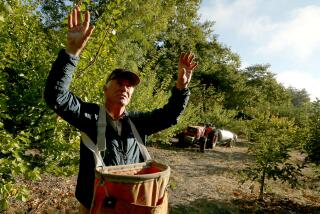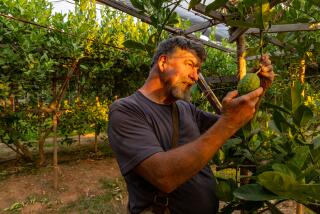Farmers Markets: A guide to the best winter citrus
Midwinter is peak time for citrus to be eaten fresh, and this year quality has been superb, probably because of the extended heat earlier in the growing season. Here are tips about which varieties to look for now and from which growing areas, including recommended growers, tips for choosing and using, and potential pitfalls. For each type there’s also a peek at what the future has to offer.
Algerian and some other clementines (from Southern California): At its best, sweet, juicy, rich-flavored, easy to peel and seedless. Drawbacks: Pollinated fruits can be seedy; there is great variation in quality by variety, grower and growing area. San Joaquin Valley clementines will soon be past, but coastal Southern California fruits should still be in prime condition through February; taste first, and be alert to signs of overmaturity (bland, off flavors). Recommended growers: Bob Polito (clearly best); Friend’s Ranches, Timber Canyon Ranch.
Future: There are dozens of new clementine varieties in Spain, earlier or later maturing, and larger than the original. It remains to be seen if any will taste as good as Algerian at its best.
Cara Cara navel orange: Pink-fleshed mutation of Washington navel, pigmented with lycopene (like pink grapefruit), with a delightful tutti-frutti flavor. Drawbacks: Color fades by the end of the season, and the flavor of some specimens is bland. Look for a slight pinkish rind blush and medium-sized fruit rather than ultra-large, which can be dry. Eat it peeled or sliced. Growers: Garcia Organic, Ken Lee, Arnett Farms.
Future: There are darker pink navels not yet grown in California, such as Kirkwood Red and California Rojo, as well as a Variegated Cara Cara.
Cocktail “grapefruit” (from Southern California). Is regular grapefruit too tart for you? The so-called Cocktail grapefruit derives low acidity from one parent, Siamese Sweet acidless pummelo, and sweet, tender flesh from the other, Frua mandarin. It’s bright golden yellow, very juicy and rather soft for shipping, but it’s a great favorite at farmers markets. Drawbacks: It’s excessively seedy, with bitter membranes. Large fruits are best for eating fresh, because it’s easier to cut away the membranes. Small fruits are fine for juicing and eating sliced. Growers: Garcia Organic Farm, Peter Schaner, Thys Ranch, Rancho Padre (juice).
Future: Breeders are trying to develop a version with fewer seeds, which would be a game changer.
Daisy mandarin: The cross of Fortune and Fremont is very sweet, with rich, complex flavor. It vies with Dekopon for top rating. Smooth, very attractive red-orange skin. Drawbacks: A bit “chippy” to peel and excessively seedy. Choose flat fruits, and beware sunburned fruits late in season. Eat by cutting into longitudinal slices. Growers: Rancho Mexico Lindo (best quality, ripe in a few weeks), Mud Creek Ranch, Arnett Farms.
Future: Fruits of a low-seeded version, DaisySL, will be available in a few years from Friend’s Ranches and JJ’s Lone Daughter Ranch. It has a firm texture but melts in the mouth, and it should be the supreme farmers market citrus when more growers catch on.
Dancy mandarin. The original Florida zipper-skin tangerine is a classic in California too, with intense wild mandarin aroma. It’s bright red, with a flat shape and thin, edible skin. Great for cooking. Drawbacks: seedy, lots of rag (high ratio of membrane to juicy pulp) and perishable. Choose fruits heavy in hand and use quickly. It adds spice to orange juice. Growers: Friend’s Ranches, JJ’s Lone Daughter Ranch, Timber Canyon Ranch.
Future: A seedless cross of Dancy and Robinson, with the excellent flavor of Dancy and few of the drawbacks, is now being planted by a large grower in Florida. It may help jump-start that state’s moribund mandarin industry, which has been beaten badly by California in the past decade.
Dekopon mandarin hybrid (sold as Sumo, from the San Joaquin Valley). Large, with a neck, pebbly golden rind, easily peeled, seedless, high in sweetness and acidity, intense mandarin flavor — as good as citrus gets. Drawbacks: Rough rind may put some off, not every fruit lives up to the variety’s potential and it’s pricey. Choose smoother fruits, and them eat peeled or sectioned. Dried Sumos can be sublime. Grower: Mike and Jonelle George, at Santa Monica Wednesday starting Feb. 6 or soon thereafter.
Future: Currently just one group of farmers grows Dekopon in California, but trees will be more widely available in several years and will fruit in about six.
Meiwa kumquat (from Southern California): Round and sweet, with thicker skin, and much sweeter than the standard oval Nagami; the best kumquat for eating fresh. Drawbacks: Seedy, less productive and not as easy to grow as Nagami and more perishable. Look for fully colored orange fruits. Growers: Garcia Organic, Coyote Growers (Jim and Jeanne Davis), Mud Creek Ranch.
Future: There are seedless forms of Meiwa in Asia, which hopefully will be grown in California some day.
Minneola tangelo. Century-old cross of Duncan grapefruit and Dancy mandarin, with vibrant red-orange rind, a distinctive neck at the top, juicy, silky smooth flesh, and rich flavor. Drawbacks: A bit strong-flavored for some palates, especially early in the season. Best eaten sectioned (wear a bib!). It makes great juice. Growers: JJ’s Lone Daughter Ranch, Thys Ranch, Gerard Joske (Ventura markets).
Future: Sugar Belle, a recent Florida hybrid of Minneola and clementine, is slightly smaller but sweeter and even richer in flavor, and a month earlier. So far it’s been planted on a limited scale in Florida, but it is worth testing in California.
Oroblanco grapefruit hybrid (from Southern California). A white grapefruit built for the limited heat (compared with Florida and Texas) of coastal Southern California inherits low acidity (for a grapefruit) from its pummelo parent, Siamese Sweet, and intense flavor from Duncan grapefruit. Drawbacks: thick rind and bitter, tough membranes. There are numerous aborted seeds in some fruits. Choose large (easier to eat), bright yellow fruits, untinged with green. Eat it sliced, stripping off membranes. Growers: Bob Polito (supreme), Garcia Organic, Peter Schaner (pre-sectioned).
Future: Oroblanco-like varieties with pink flesh are available abroad, and others are being tested in California.
Ruby or Star Ruby grapefruit (from the desert): Desert-grown grapefruit can be great all winter, but midwinter is arguably the peak: Too early it can still be tart; right now it’s plenty sweet and juicy. By spring it can be mushy or dry. Drawbacks: Flavor is too strong for some; bitter membranes; interacts with many medications. Look for fruits that are heavy for their size, with smooth skin, and flat shape; eat sliced, or halved, with a grapefruit spoon. Growers: Everett Davall, Flying Disc Ranch. At supermarkets, grapefruit from Florida and Texas are well worth considering.
Future: Super-dark red grapefruit have been found in Texas, where they are being tested. Florida researchers have developed grapefruit hybrids that don’t interact with medication.
Tarocco blood orange: The supreme Italian table orange has sweet, tender flesh. Drawbacks: It doesn’t color as darkly or dependably as Moro and can take many years to bear high-quality fruit. Fruits with orange rinds can still be excellent, but light flesh color is also acceptable. Eat it sliced or peeled. Growers: Friend’s Ranches, Timber Canyon Ranch, Fife Family Farms, Crown 12 Ranch, JJ’s Lone Daughter Ranch (later in February).
Future: Italy has more than a dozen selections of Tarocco, maturing from November to May, some with more dependable color than California’s clone.
Washington navel orange: California’s classic, most-grown citrus is peelable and seedless. Fruits from most districts should be at peak flavor by now. Drawbacks: It’s not quite as juicy as some other oranges, and the flavor can be bland. The juice develops a delayed bitterness. Choose smooth-skinned fruits, medium rather than huge. Eat them peeled or sliced. Growers: The Grove (Hassan Ghamlouch), Mike Agnew, Bernard Ranches, Burkart Farms, Thys Ranch.
Future: To distinguish their fruits and earn a premium, more marketers are touting fully mature, old-line Washington navels grown on the best rootstock in the best microclimates as “heirloom navels” or some such.
W Murcott Afourer mandarin: Of Moroccan origin, with a bright red rind that’s easily peeled. It’s seedless when grown in isolation and can have very good flavor. Sold commercially as Cutie, Delite, etc. Drawbacks: Can be seedy when grown next to other citrus with viable pollen, and it’s susceptible to freeze damage. Be alert for freeze damage, especially on San Joaquin Valley fruit. Eat it peeled or sliced. Growers: Friend’s Ranches (clear choice, most aromatic), Ken Lee.
Future (here now): Tango, nearly identical to W Murcott but always seedless, has been planted in California on more than 6,000 acres, most of which are starting to produce now. Growers: JJ’s Lone Daughter Ranch, Etheridge Farms.
More to Read
Eat your way across L.A.
Get our weekly Tasting Notes newsletter for reviews, news and more.
You may occasionally receive promotional content from the Los Angeles Times.






